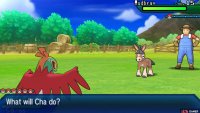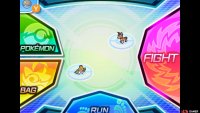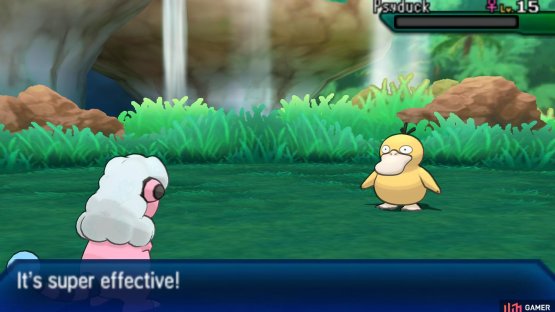(1 of 2) The most frequent button you’ll press is the biggest one: Fight.
The most frequent button you’ll press is the biggest one: Fight. (left), (right)
Pokemon battles are the bread and butter of the Pokemon world. If you intend to go anywhere in Alola, you’ll need to battle your way through hoardes of wild Pokemon staking their turf and legions of Pokemon trainers who take their hobby very seriously.
Basics of Battles¶
Whether you’re facing a wild Pokémon or a rival trainer’s Pokémon, the mechanics are the same for both. Most battles will be between two Pokémon–yours and the opponent’s. The Pokémon that you send out will be the first Pokémon in your party–the one in the top-left corner. If that Pokémon has fainted, you will use the next available one instead.
Once a battle is underway, you can choose from the following options on the bottom screen:
Choosing your Moves¶
After selecting “Fight”, you can then pick one of your Pokemon’s moves. Each Pokemon can have up to 4 moves at their disposal. Moves can be learned via Level Up, evolution, by using TM items or other means. If a Pokemon tries to learn a new move when they have 4 already, you’ll be asked to delete an old move or give up learning the new one.
Moves can have a variety of effects; most deal damage to the opposing Pokemon, but others may cause status effects or a combination of both. Each move has a PP (Power Point) value, which determines how many times the Pokemon can use the move before it needs replenishing. As a general rule of thumb, moves with less PP are better.
The final thing to note is that each Pokemon and each move has a characteristic Type (and some Pokemon can have two Types). These Types range Normal, Fire, Grass, all the way to Dark, Steel and Fairy. Types are very important as they greatly influence the amount of damage dealt. See our Type Match-Ups page just ahead for the full scoop!
Battle Outcomes¶
(1 of 2) There’s no need to stress like Psyduck: you either win or you lose.
There’s no need to stress like Psyduck: you either win or you lose. (left), (right)
Having selected a move, the Pokemon with the higher Speed stat will execute their move first, followed by the other Pokemon. If a Pokemon uses a damage-dealing move, it may reduce the opposing Pokemon’s HP. Once a Pokemon falls to 0 HP, it will faint and be removed from battle.
If you manage to successfully faint a Pokemon (or catch a wild Pokemon), your Pokemon will gain experience and eventually Level Up, improving their stats and occasionally gaining new moves or even evolving into a stronger creature.
Defeating or capturing a wild Pokemon immediately ends the battle. However, if you’re facing another Pokemon trainer, they may send out another Pokemon to continue the battle. Just like you, other trainers can have up to 6 Pokemon, although most rarely have more than 3.
The battle ends once either trainer has exhausted all of their Pokemon. Of course, the victor is the trainer with at least one Pokemon still standing. In addition to earning valuable experience, you will also be rewarded with Poke Dollars (money) for besting a fellow trainer.








No Comments